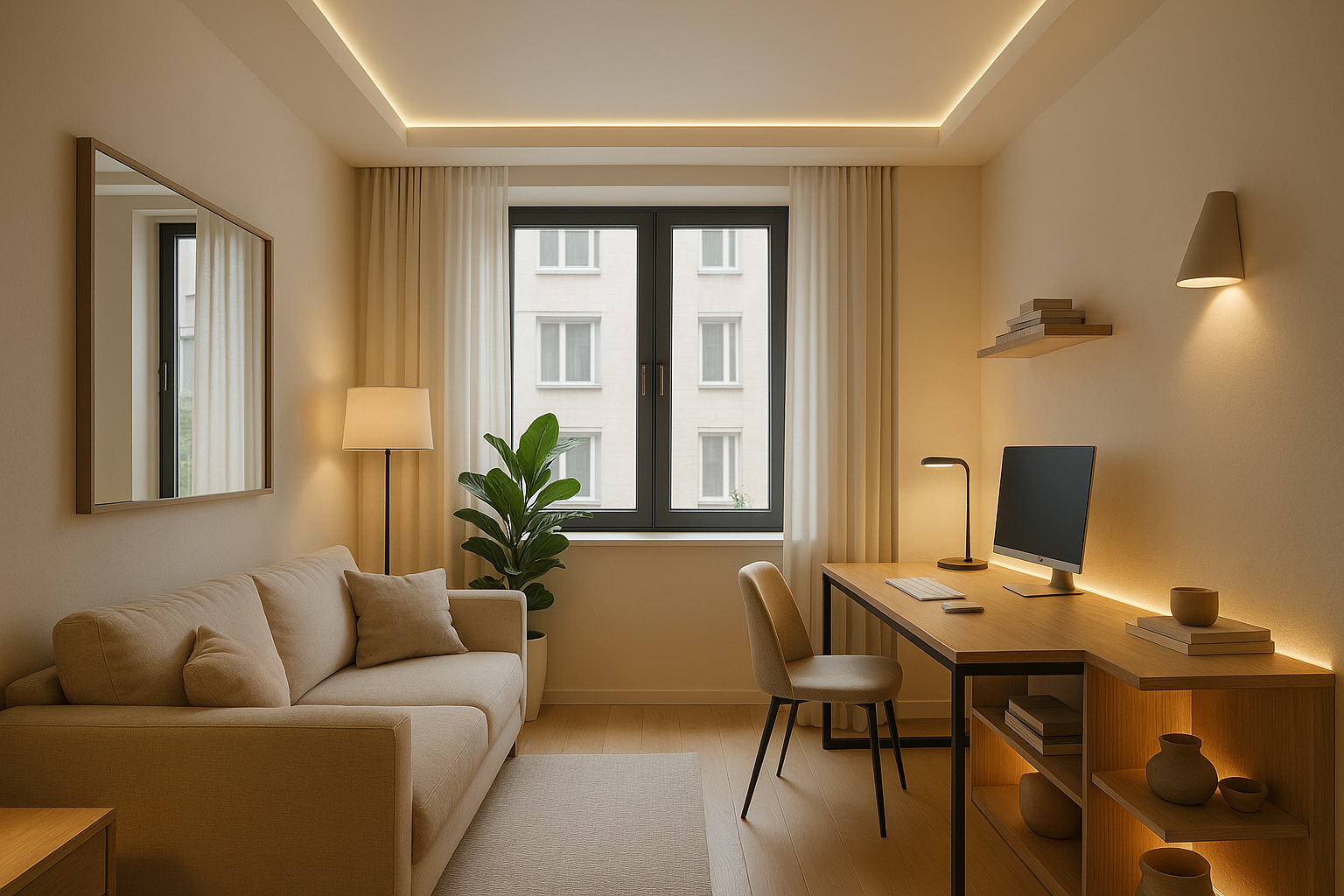When it comes to decorating small apartments, lighting plays a crucial role—not just in functionality, but also in how spacious and welcoming your home feels. In compact living spaces, especially those that double as a home office, the right lighting can completely transform the environment. Good lighting enhances focus, creates a pleasant ambiance, and most importantly, makes your home appear larger than it really is.
In this article, we’ll dive into practical and effective lighting tips for small apartments that help maximize your space and make your home office both cozy and efficient.
Why Lighting Matters in Small Apartments
Before we dive into techniques, it’s important to understand why lighting is so powerful in small spaces:
- Creates the illusion of space: Well-placed lighting can make rooms feel more open and airy.
- Defines zones: In multipurpose rooms, lighting helps visually separate spaces—like your home office from your bedroom or living area.
- Boosts productivity: Especially in a home office, proper lighting reduces eye strain and improves focus.
- Enhances design: A thoughtfully lit room feels more polished and inviting.
Now let’s explore how to use lighting to your advantage.
1. Maximize Natural Light
Nothing beats natural light. It makes a space feel fresh, bright, and naturally larger. If you’re lucky enough to have windows in your apartment, you’ll want to make the most of them.
How to do it:
- Keep windows unobstructed: Avoid heavy curtains or bulky blinds. Instead, go for sheer curtains or roller blinds that allow light to filter through.
- Use light-reflective colors: White or pale-colored walls bounce natural light around the room.
- Place mirrors opposite windows: Mirrors reflect light and give the illusion of depth, which makes rooms look bigger.
- Avoid placing furniture in front of windows: This can block light and make your space feel darker and smaller.
If you work from home, consider setting up your home office close to a window to benefit from daylight during working hours.
2. Layer Your Lighting
Layered lighting means using multiple types of light sources to add depth and functionality to your space. This is especially important in small apartments, where one ceiling light often isn’t enough.
The 3 basic types of lighting:
- Ambient lighting: General lighting that provides overall illumination (ceiling lights, flush mounts).
- Task lighting: Focused lighting for activities like reading or working (desk lamps, under-cabinet lights).
- Accent lighting: Adds visual interest and highlights decor (LED strips, wall sconces, fairy lights).
Example setup:
- A flush ceiling light for ambient lighting.
- A desk lamp with adjustable brightness for your home office.
- A small floor lamp next to your sofa or bed for accent and reading.
Mixing these layers adds functionality and makes your space feel thoughtfully designed.
3. Choose Light Fixtures That Save Space
In small homes, every square inch counts. That means floor and table space should be kept clear whenever possible. Opt for lighting fixtures that don’t take up valuable surface area.
Best options:
- Wall sconces: Mounted to the wall, perfect for beside the bed or in your home office area.
- Pendant lights: Great above dining tables or work areas.
- Under-cabinet lights: Ideal for kitchens or desks placed against walls.
- Track lighting: Can be directed to various parts of a room without the need for multiple fixtures.
Avoid bulky chandeliers or oversized lamps that overwhelm the room. Stick with clean, minimalist designs that visually “disappear.”
4. Use Dimmable Lights for Versatility
Dimmable lights let you adjust brightness according to the time of day or your activity. They’re a great tool for small apartments because they let one light fixture serve multiple purposes.
Why it helps:
- Bright for work or cleaning
- Dimmed for relaxing or watching movies
- Adjustable mood lighting adds atmosphere without additional fixtures
Smart bulbs are a great investment here—they often come with adjustable brightness and color temperature, and can be controlled from your phone or voice assistant.
5. Pay Attention to Light Temperature
The “temperature” of light refers to its tone—whether it’s cool and blue or warm and yellow. Choosing the right temperature can affect how large and comfortable your space feels.
Light temperature guide:
- Cool white (4000K–5000K): Stimulates alertness and focus. Ideal for home offices.
- Warm white (2700K–3000K): Feels cozy and inviting. Good for bedrooms and living areas.
- Daylight (5000K–6500K): Mimics natural light. Can be great for areas with little sunlight.
Tip: Avoid mixing too many color temperatures in the same room, as it can make the space feel visually chaotic.
6. Reflect Light with Glossy and Metallic Finishes
You can amplify light in your space without adding more bulbs. Reflective surfaces help distribute light evenly and add a touch of elegance.
Materials that reflect light:
- Mirrors
- Glass tabletops
- Glossy tiles or paint finishes
- Metallic decor items like vases, trays, or lamps
In a small home office, a desk with a white or glossy finish can reflect task lighting and brighten your workspace.
7. Add LED Strips for Subtle and Modern Illumination
LED strip lights are a fantastic solution for both ambiance and function. They’re easy to install and can fit in tight spaces.
Where to use them:
- Under shelves to illuminate storage
- Behind a monitor for eye comfort
- Around a mirror to create a “vanity” effect
- Along the ceiling for soft overhead glow
They come in various tones and colors, and many versions are dimmable or color-changing via remote or app.
8. Use Floor Lamps Strategically
If you have space for a floor lamp, make it work hard for you. Slim, tall floor lamps with adjustable heads can act as both ambient and task lighting.
Placement tips:
- Corner of a room to bounce light off walls
- Next to a reading chair or couch
- Behind your home office chair to reduce screen glare
Avoid lamps with large, heavy bases or oversized shades. Go for minimalist designs that don’t dominate the room.
9. Don’t Forget About Lighting Decor
Light fixtures aren’t just functional—they’re a big part of your apartment’s aesthetic. Even in small spaces, the style of your lamps and bulbs can make a big visual impact.
Ideas to elevate your space:
- Swap plain bulbs for vintage Edison bulbs in visible fixtures
- Choose sculptural lamps or interesting wall sconces
- Use twinkle lights or fairy lights to create cozy ambiance at night
This works particularly well in bedrooms or reading corners.
10. Keep Light Switches Accessible
No one wants to fumble in the dark. Especially in multifunctional small spaces, smart placement of switches and controls helps improve convenience.
How to manage:
- Use smart plugs or smart bulbs for voice or app control
- Install stick-on remotes or wireless light switches
- Keep your workspace lamp switch easily reachable while seated
For extra ease, group lights by zones—such as “Work,” “Relax,” and “Sleep”—using smart home routines.
Make the Most of Light to Expand Your Space
Lighting is one of the most powerful design tools in a small apartment. With thoughtful choices—like layering different types of light, maximizing natural brightness, and using slim, space-saving fixtures—you can dramatically improve how your apartment looks and feels.
By combining aesthetics with practicality, your home will not only appear larger and more comfortable but also become a more pleasant and productive place to live and work.
Whether you’re creating a tiny home office or brightening your entire living space, good lighting will always be one of your greatest allies.

